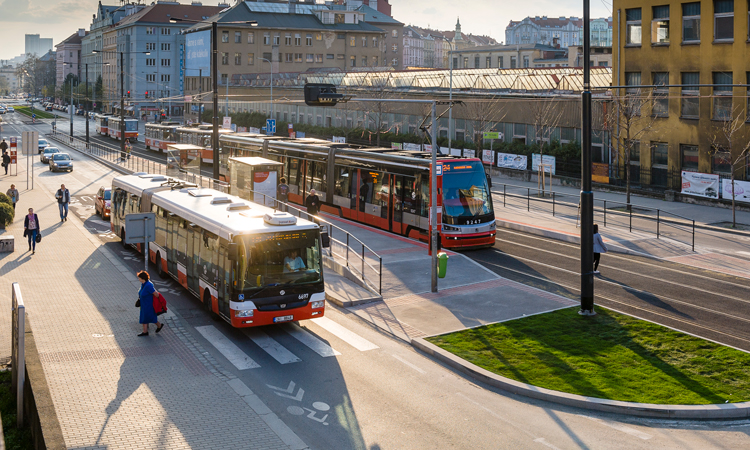Seamless mobility for passengers in Prague
- Like
- Digg
- Del
- Tumblr
- VKontakte
- Buffer
- Love This
- Odnoklassniki
- Meneame
- Blogger
- Amazon
- Yahoo Mail
- Gmail
- AOL
- Newsvine
- HackerNews
- Evernote
- MySpace
- Mail.ru
- Viadeo
- Line
- Comments
- Yummly
- SMS
- Viber
- Telegram
- Subscribe
- Skype
- Facebook Messenger
- Kakao
- LiveJournal
- Yammer
- Edgar
- Fintel
- Mix
- Instapaper
- Copy Link
Posted: 15 February 2017 | Martin Gillar - DPP | No comments yet
Prague covers an area of 496km squared and has a population of 1.25 million inhabitants. Every day approximately 200,000 commuters and 20,000 visitors travel to the Czech Republic’s capital so ensuring the reliable movement of roughly 1.5 million people in the city is a challenge. Martin Gillar, Chairman of the Board of Directors and Director General of Prague Public Transit Company (DPP), explains that seamless public transport mobility is a key element in keeping the city moving.


Public transport in the city and in suburban areas is organised in the manner of an integrated transport system that comprises the metro, trams, urban and suburban bus lines, the funicular, ferries and railways. The system is gradually becoming integrated with standard transport and tariff conditions and uniform transport solutions, including the coordination of the timetables of all of the 17 operators that are involved. The strategy of the city is to reduce the number of cars on the streets. In addition, to make this more complex, the city’s strategy regarding both commuters and visitors necessitates that they leave their cars in the suburbs and continue their journey to the city centre using public transport. In the suburban areas there are 16 huge intermodal hubs that are close to metro stations and in which the metro service, the suburban bus service and the park and ride service are integrated into one large terminal. Over the coming years the number of intermodal hubs, including park and ride facilities, will increase.
DPP – being the dominant public transport operator within Prague that operates the entire metro and tram service and approximately 85% of all bus services – is very pleased with the popularity of public transport within the city. Modal distribution of trips in accordance with the mode of travel is a favoured strategy; 57% of all journeys are taken by public transport.
For almost 50% of all public transport passengers, the metro is the fundamental public transport mode in Prague and forms the backbone of the public transport network. The first metro line was opened in 1974 and over the subsequent four decades has become a key facet of the city’s public transport system. The tram is another important and popular mode of transport, and carries almost 30% of all passengers. From an environmental perspective it is important to highlight that approximately 80% of all urban public transport passengers use environmentally-friendly urban rail electric transport. Intermodal hubs are located mainly at stops and stations at street level where the metro meets trams and/or buses. The main goal is to provide public transport passengers with effortless door-to-door transfers between each of the public transport modes. Currently barrier-free access to metro stations and street-level transport stops are both common features. Wheelchair access points represent a large and visible effort by DPP to provide a maximal degree of service for accommodating the needs of passengers with reduced mobility and impaired orientation.
DPP understands that the sustainability of public transport in the city goes hand-in-hand with the accessibility of all public transport modes. Accessibility is not only about offering low-floor buses and trams, but also about barrier-free bus and tram stops that enable comfortable transfers between different public transport modes. In the context of public transport infrastructure, the upgrading and improvement works initiated by DPP have started to provide more convenience for passengers. Where the conditions of the infrastructure allow (enough space, updated technical parameters, safety etc.) common bus and tram stops are being built.
The metro is the most important public transport mode and passengers can transfer between metro lines and buses or trams at transfer stations and stops. However, to make tram and bus transport as efficient and effective as the metro, street-level public transport must become more fluid, especially in congested areas where the infrastructure is shared with individual car transport. Numerous priority measures for trams have been introduced at almost all crossroad traffic lights. Shorter travel times and the more fluent and efficient operation of trams are provided via the sensors system on the overhead line. In the case of buses the system has a similar principle; to speed-up the bus when it is passing through the crossroad’s traffic lights.
DPP has recently considered cycling as an element of intermodal transport and increasing numbers of cyclists are beginning to use the city’s streets. DPP is supporting sustainable mobility and environmentally-efficient modes of transport: cyclists can use the metro without any time limitations, and storing bicycles on-board trams is permitted when travelling out of the city to a suburb. Since 2016 a pilot project for bicycle transport on urban bus lines has been implemented. Bringing a bicycle on-board is free-of-charge because it is a means of contributing to reducing the traffic load by using environmentally-friendly modes of transport, while also promoting a healthy lifestyle for passengers.
Intermodality cannot stand alone. Intermodality is based on sustainable public transport and vice versa; public transport accessibility represents an aspect of sustainability – so it is full circle. DPP benefits from providing a complex urban public transport service including the metro, trams and buses. All the public transport modes together constitute a single functional unit. The intermodality approach forms only one part of the high quality services that urban public transport provides. Prague achieves more sustainable public transport by providing increasingly safe, environmentally-friendly and convenient conditions. With additional investment in the public transport system the alternatives to individual car transport will become more and more attractive. In many ways Prague has been adapting the transport policies of modern cities since 1999. Measures that have been implemented in recent years have resulted in an increase of public transport users from 1.03 billion trips in 2000 to 1.19 billion trips in 2016 (an increase of 15%).
Biography


Related topics
Multimodality, Passenger Experience, Sustainable Urban Transport
Issue
Issue 1 2017
Related cities
Prague
Related organisations
Prague Public Transit Company (DPP)
Related people
Martin Gillar








